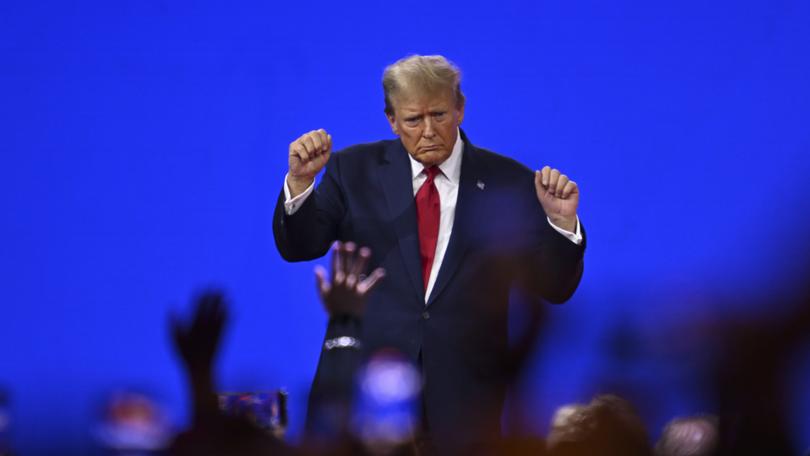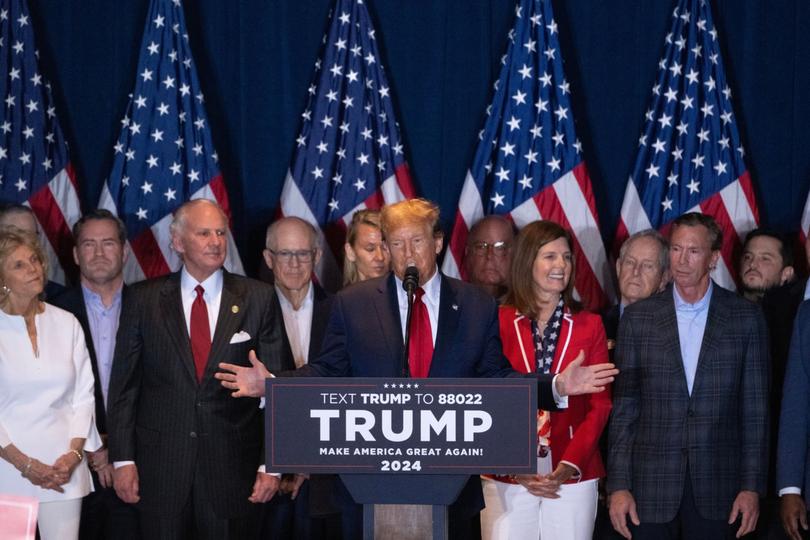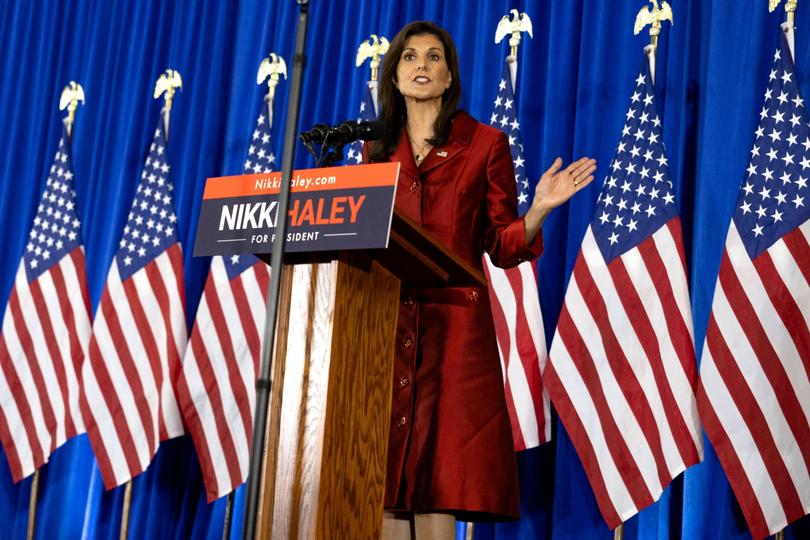The New York Times: Five takeaways from Trump’s big win over Nikki Haley in South Carolina

Donald Trump lapped Nikki Haley in the Midwest. He beat her in the Northeast. He dominated in the West. And now he has trounced the former two-term governor in her home state of South Carolina.
After nearly six weeks of primary contests in geographically, demographically and ideologically diverse states, even Haley’s most ardent supporters must squint to see the faintest path to the presidential nomination for her in 2024.
The race was called the moment the polls closed, and within minutes an ebullient Trump took the stage, avoiding a mistake he made in New Hampshire when Haley spoke first and, even in defeat, gave a rousing speech that had irked him.
Sign up to The Nightly's newsletters.
Get the first look at the digital newspaper, curated daily stories and breaking headlines delivered to your inbox.
By continuing you agree to our Terms and Privacy Policy.“It’s an early evening,” Trump beamed.

But Haley, a former United Nations ambassador, is still vowing to plow on, warning her party that sticking with Trump and the distractions of his four criminal indictments is a pathway to defeat in November.
“Today is not the end of our story,” she declared.
Here are five takeaways from the South Carolina primary and what comes next:
It was a home-state failure for Haley.
She campaigned more aggressively. She spent more on television advertisements. She debuted a shiny new bus to traverse the state, and kept raking in donations.
Then, she lost decisively.
Haley’s advisers have carefully and successfully managed the expectations-game part of the presidential primary so far — taking great pride in avoiding setting any specific metrics that she must achieve in order to be considered a success. Sure, she was disappointed to finish third in Iowa, but she still cast it as a two-person race (correctly, when Ron DeSantis quickly dropped out). Sure, she didn’t win in New Hampshire, a state that had big turnout from independents and where she had the backing of the popular governor, but she did grow her share to 43% and lost by less than some polls suggested.
Managing expectations helped her outlast “all the fellas,” as she calls her former non-Trump rivals, but she has outlined no strategy to outpace that pesky last “fella.”
There was little spinning Saturday’s result. The one metric her team had set was that she needed to keep growing her support but she was tracking near 40% when she took the stage Saturday night.
“I’m an accountant,” she said. “I know 40% is not 50%. But I also know 40% is not some tiny group.”
It also is not a winning group.
Trump was leading among men and white voters, according to exit polls, dominating both in rural areas and in the suburbs that Haley has projected as his electoral weakness in the fall. He was leading among every age group. Haley was only winning moderate and liberal primary voters, while fighting college educated voters to close to a draw.
The race was called so quickly that at Haley’s election night party in Charleston, the ballroom held only a smattering of people as the wait staff passed around appetizers. The sound system went from blaring CNN’s call of the results to playing upbeat music by 7:03 p.m.

Voters looked past Trump’s legal woes and political missteps.
It has been a month since New Hampshire, the last significant race that pitted Trump directly against Haley. And, despite the lopsided outcome Saturday, Trump did not coast through those weeks error-free and unscathed.
A New York judge ordered him to pay $450 million for inflating his worth and deceiving lenders. A Manhattan jury ordered Trump to pay $83 million to writer E. Jean Carroll for defaming her after she had accused him of rape. A late March trial date was set for Trump’s indictment surrounding hush-money paid to a porn star in 2016. And campaign filings revealed that Trump spent north of $50 million on legal bills in 2023.
Those were just the legal issues.
Trump said he would “encourage” Russia “to do whatever the hell they want” to European countries that had not paid sufficient money to the NATO alliance, a comment President Joe Biden’s campaign turned into battleground state ads. Trump moved to install his daughter-in-law as co-chair of the Republican National Committee, prompting some charges of nepotism.
And he mocked Haley’s husband, Michael Haley, who is deployed to Africa with the National Guard, in a state with a proud military tradition, comments that her super political action committee quickly turned into an ad calling Trump “sick.” A South Carolina exit poll showed Trump winning nearly 70% of voters who were military veterans.
In other words, Republican voters shrugged it all off. That, as much as anything, feels like a sign they have made up their collective mind on who should lead them this year.
But allies of Haley said that her “not some tiny group” of supporters also portended trouble for Trump in November if he failed to win them back.
To win a Republican primary, you really need Republicans.
The political problem for Haley runs deeper than the already rough top-line results. In New Hampshire, she rose to 43% of the vote overall. But that strength, even in defeat, was almost entirely because of the support of independent voters. Among Republicans, the exit polling showed that Trump won 74% to Haley’s 25%.
In other words, roughly two-thirds of her support came from Democrats and independents.
It was a similar story in Iowa, where she performed far better among independents (34%) than Republicans (15%), according to entrance polling. And in Nevada, Haley embarrassingly lost to a “none of these candidates” option by more than 30 percentage points in a contest in which Trump was not on the ballot. She did not campaign there, but the result showed the lack of organic support.
In South Carolina, the early exit polling showed more of the same. Trump was crushing Haley with 73% support among Republicans to her 26%. She was still winning 54% of independents, but they made up only 21% of the electorate, while roughly 7 in 10 voters were Republican.
Her standing as an outsider in her own party in her own state was underscored by Trump’s backing from the GOP establishment: both United States senators, the governor, and most of the congressional delegation, including Rep. Nancy Mace, whom Haley helped defeat a Trump-backed challenger in 2022.
The next major day on the primary calendar is Super Tuesday, March 5, when 15 states and one territory vote and a major chunk of delegates are awarded. Some of those contests are entirely closed to independent and Democratic voters, making Haley’s path even steeper.
One nonprofit linked to Haley has already aired a television ad explicitly trying to lure Democrats and independents to the polls.
Haley’s reliance on Democratic support — among both donors and voters — has become a top talking point for the Trump team. “All she’s trying to do is inflict pain on us so they win in November,” Trump said Friday. “We’re not going to let that happen.”
Haley isn’t giving up her case that Trump can’t win.
The Haley campaign cannot name a state she will win. But she is set to continue a grueling schedule in the days before Super Tuesday on March 5: Michigan to Minnesota to Colorado to Utah, then Virginia, Washington, D.C., North Carolina and Massachusetts.
Haley’s closing argument has boiled down to this: She might not be able to win the primary, but Trump can’t win a general election. Unfortunately for her, there is no such thing as an immaculate nomination.
“We know the odds here, but we also know the stakes,” Haley’s campaign manager, Betsy Ankney, said on the eve of South Carolina’s election.
In her increasingly frequent media appearances, Haley has sharpened the electability argument that has been at the core of her candidacy for months. Republicans, she says, have been losing almost continuously since Trump arrived on the scene — in 2018, 2020, 2022 and 2023. A Trump-topped ticket spells disaster not just for the White House, but the House and Senate, she argues.
But her own defeats — in Iowa, New Hampshire, Nevada and now South Carolina — have undercut that case of its strength. It’s hard to argue your opponent is losing when he’s winning.
All that’s left is the delegate math — and money.
For all of Trump’s success to date, he still has only a fraction of the delegates he needs to ultimately secure the nomination.
The calendar accelerates dramatically from here, and he is well positioned to sweep some of the most delegate-rich states, especially California, where the Trump team engineered especially beneficial rules, in March.
Haley has argued it is worth letting the voters actually vote. “They have the right to a real choice — not a Soviet-style election with only one candidate,” she said Saturday.
In a recent memo, the Trump team argued that even applying Haley’s 43% showing in New Hampshire to all the contests in the upcoming weeks, Trump would secure the delegates needed to win the nomination by March 19. If he performs better, he could secure a sufficient number of delegates a week earlier.
“The end is near,” wrote Chris LaCivita and Susie Wiles, Trump’s co-campaign managers.
The actual end of the 2024 primary will come when Haley exits, and the typical pressure point for that is cash. But Haley outraised Trump in January and, by all accounts, has the money to continue campaigning on and made clear she plans to stay in through Super Tuesday.
At her election party in Charleston, where CNN was back playing over the speakers about an hour after the polls had closed, one of the analysts could be heard saying she could stay in “as long as she has the money to keep the lights on.”
The crowd cheered.
This article originally appeared in The New York Times.
© 2024 The New York Times Company
Originally published on The New York Times
